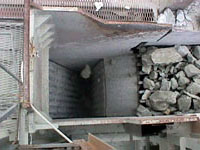
Most of the information presented on this page was provided by the Indiana Mineral Aggregates Association.
The aggregates industry constitutes an integral segment of the nation's economy by providing raw material for highway construction, as the primary ingredient in concrete and asphalt and for a variety of other vital elements of everyday life. Aggregate raw material consists of crushed limestone, crushed dolomite, and sand and gravel. Some important facts concerning the value of aggregates to our economy include...
- Aggregates are produced from 265 surface and underground mines located throughout the state.
- Each year about 27,500 pounds of aggregate are directly or indirectly used by each resident of Indiana.
- 400 tons of aggregate are required to build the average home in America.
- More than 80 million tons of crushed stone and sand and gravel are produced each year in Indiana.
- Most crushed aggregate is used within a 50-mile radius of the extraction site.
- Indiana ranks 11th nationally in the production of crushed stone and 13th in sand and gravel.
- The average productive period of a gravel pit is 25 years, and the productive life of a limestone quarry averages 50 years.

Electric shovel loading stone into a hauler
You may be interested to know that...
- For every mile a load of aggregate must be transported from its extraction site, its cost increases by about 10 cents per ton.
- One mile of two-lane, concrete highway 24 feet wide by 12 inches thick requires 7,205 tons of course and fine aggregate.
- One mile of two-lane asphalt pavement 24 feet wide by 14 inches thick requires 10,300 tons of aggregate.
- Pulverized limestone and dolomite play a key role in the preservation of clean air (see "Using limestone for cleaner air" in Indiana University Research & Creative Activity, January 1998, Volume XX, Number 3) by helping to remove sulfur compounds from stack gases that result from the burning of coal in electric power generating stations. Finely powdered dolomite (and some limestones) helps ensure more thorough and efficient burning of coal by its addition to fluidized bed combustion chambers.
- Chemically pure forms of limestone and dolomite are essential ingredients in many plastics, paper products, insulation, toothpaste, carpeting, roofing, glass, and household cleaners to name a few.
- Abandoned aggregates mines have been reclaimed for recreational, industrial, and other uses. For example, underground mines near Marengo, Indiana are now being used as warehouses (see Marengo Warehouse and Distribution Center web site).

Stone being fed into a typical jaw crusher.
Photos By: IMI

Conveyors provide a safe, clean, and efficient method of transporting materials at and aggregates operation.
Photo by: IMI


"If it can't be grown, it has to be mined"
For more information pertaining to the aggregates industry in Indiana, contact the Coal and Industrial Minerals Section
of the Indiana Geological Survey at 812-855-2687, or contact the:
Indiana Mineral Aggregates Association
11711 N. College Avenue, Suite 180
Carmel, IN 46032-5601
Phone: (317) 580-9100
FAX: (317) 580-9183
Web site: www.indmaa.org


